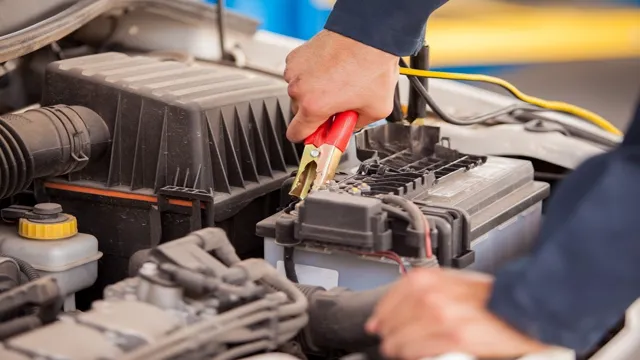Maximizing Your Electric Car’s Battery Cycle Life: Tips and Tricks for Longevity
As we strive towards a greener future, electric cars have become increasingly popular. However, one concern that potential buyers often have is the lifespan of the battery that powers the vehicle. After all, investing in an electric car is a significant financial commitment, and no one wants to have to replace the battery after just a few years.
This is where the concept of “electric car battery cycle life” comes into play. Essentially, this refers to how many charge and discharge cycles a battery can undergo before its performance begins to decline. Understanding this concept is crucial for anyone considering purchasing an electric vehicle, and in this blog post, we’ll delve deeper into what it entails and what factors can affect it.
So, buckle up and let’s explore the world of electric car batteries!
What is Battery Cycle Life?
Electric car battery cycle life is the number of charge cycles a battery can endure before it starts to degrade and lose its capacity to hold charge. Each cycle involves charging the battery to its full capacity and discharging it until it reaches a low state of charge. The average electric car battery can withstand around 1000 to 1500 charge cycles, meaning that it can last for several years depending on how often it is used and how well it is maintained.
Factors such as temperature, charging habits, and driving style can also affect the battery cycle life, so it is important to take care of your electric car battery to get the most out of it. Regular maintenance, such as keeping the battery charged and avoiding excessive heat or cold, can help extend its lifespan and keep your electric vehicle running smoothly.
Explanation of the term
Battery Cycle Life refers to the number of charge and discharge cycles a battery can undergo before its capacity begins to degrade. In simpler terms, it’s the amount of time a battery can be charged and used before it starts losing its ability to hold a charge. The cycle life of a battery depends on various factors, including the type of battery, the depth of discharge, temperature, and the charging method.
Generally, lithium-ion batteries have a longer cycle life than other types of batteries, and their cycle life can range from 300 to 5000 cycles. However, it’s important to note that the cycle life is not an exact measure of a battery’s lifespan, as other factors, such as age and usage patterns, can also affect its performance. Keeping your battery cool, charging it with the proper voltage and not letting it discharge completely can help maximize its cycle life.
Factors affecting cycle life
Battery cycle life refers to the number of charge and discharge cycles that a battery can undergo before its performance begins to degrade significantly. There are several factors that can affect the cycle life of a battery, including temperature, depth of discharge, and charging rates. High temperatures can accelerate degradation and shorten the cycle life of a battery, while keeping the battery at a cool temperature can help prolong its life.
Additionally, discharging a battery too deeply can also impact its cycle life, so it’s important to avoid completely draining the battery whenever possible. Finally, charging rates that are too high can cause damage to the battery and reduce its overall cycle life. Keeping these factors in mind and practicing proper battery maintenance can help ensure that your batteries last as long as possible.
Cycle Life of Electric Car Batteries
Electric car battery cycle life refers to the number of times an electric car battery can be charged and discharged before losing its efficiency. The cycle life of an electric car battery depends on several factors such as temperature, age, charging time, and depth of discharge. The depth of discharge refers to the amount of energy taken out of the battery during each cycle, and it is recommended to keep it between 20% and 80% to prolong the battery’s cycle life.
Moreover, extreme temperatures can have a detrimental effect on battery performance and should be avoided. With proper care and maintenance, electric car batteries can offer a long cycle life, typically ranging from 1000 to 2000 cycles or more depending on the model and manufacturer. As the technology for electric car batteries continues to evolve, we can expect to see even longer cycle lives in the future.
Comparison of different types of batteries
When it comes to electric car batteries, one important factor to consider is the cycle life. This refers to the number of charge/discharge cycles a battery can go through before its performance starts to degrade significantly. Different types of batteries have different cycle lives, which makes them better suited for different applications.
For example, lead-acid batteries have a relatively short cycle life of around 300-500 cycles, which makes them better suited for applications where they won’t be used frequently, but need to provide a lot of power when called upon. Lithium-ion batteries, on the other hand, have a much longer cycle life of around 1000-1500 cycles, which makes them better suited for applications where they will be used frequently, but don’t need to provide as much power at any one time. Ultimately, the choice of battery type depends on the specific needs of the application, but knowing the cycle life of different batteries can help make an informed decision.
Real-world examples of cycle life
Electric car batteries have a significant impact on the vehicle’s overall performance, and cycle life is an essential parameter to consider while choosing a battery. The cycle life is defined as the number of charging and discharging cycles that a battery can undergo, after which its capacity degrades significantly. It directly impacts the longevity of the battery and its capacity to store energy.
Most of the electric car batteries available in the market today have a cycle life of around 1000 cycles, which leads to a battery lifespan of 8 to 10 years. However, Tesla’s Model S battery has set a new standard with a cycle life of 250,000 miles, which is equivalent to 1500 cycles. The electric car manufacturer Fisker is also making waves with its new solid-state battery technology, which claims to have a cycle life of over 500,000 miles, equivalent to around 2,500 cycles.
These real-world examples are exciting developments in the electric vehicle industry and have the potential to revolutionize the way we look at electric car batteries.
Impact of driving habits and charging method
The cycle life of an electric car battery greatly depends on your driving habits and charging methods. The way you drive your electric vehicle can have a huge impact on the life of the battery. If you have a lead foot and are constantly accelerating and decelerating, you will be draining the battery more quickly.
Similarly, if you are regularly driving on steep inclines or in hot weather, this can also contribute to a shorter battery life. On the other hand, if you are a more conservative driver and take lighter brakes and smoother accelerations, your batteries will last longer. In terms of charging, the way you charge your electric car battery can also affect its overall life.
Fast charging regularly can lead to battery degradation and a shorter lifespan. So, it’s crucial to use an appropriate charging station for your electric car battery, as overcharging can be as damaging as undercharging. In conclusion, it’s important to keep these factors in mind if you want to maximize the cycle life of your electric car battery.
Prolonging Battery Cycle Life
When purchasing an electric car, one of the most significant concerns for drivers is the battery cycle life. The longer the battery lasts, the better. Therefore, it is vital to understand how to prolong the battery cycle life of an electric car.
The first step is to avoid charging the battery to 100% every time. Although it may be tempting to get the full power out of the battery, it’s not worth the damage it can do in the long run. Additionally, frequent fast charging should be avoided as it puts a lot of stress on the battery and can reduce its lifespan.
Another crucial factor in prolonging the battery life is parking in shaded areas and not exposing the car to high temperatures for too long. This way, the battery can cool down instead of overheating, which is a common cause of battery degradation. Lastly, regular maintenance and keeping an eye on battery health can ensure that any issues are caught early and can be addressed before it’s too late.
By following these tips, electric car owners can extend their batteries’ cycle life and enjoy their cars for years to come.
Maintenance and care tips
If you want to prolong the battery cycle life of your devices, there are a few maintenance and care tips you should consider. One important step is to avoid overcharging your battery. Using a charger that automatically stops charging once the battery is full can help prevent overcharging and reduce the risk of damage to the battery cells.
Another tip is to keep your battery cool and avoid exposing it to extreme temperatures. High temperatures can cause the battery to degrade faster, while low temperatures can reduce its capacity. Additionally, it’s important to use the right charger for your device and avoid using counterfeit or cheap chargers that can damage your battery.
By following these simple tips, you can ensure that your battery lasts longer and performs at its best.
Best practices for charging
Battery cycle life can be prolonged by following some best practices for charging. One of the most important things to keep in mind is to avoid letting your battery completely drain out before charging. This is because lithium-ion batteries used in smartphones and laptops have a limited number of charge cycles and performing frequent complete discharges can reduce the overall battery life.
It is also important to avoid overcharging by monitoring your device’s charging rate. Unplugging the charger once it reaches full charging capacity is recommended to prevent overcharging. Additionally, charging your device in a cool and ventilated area is recommended as higher temperatures can damage the battery.
Implementing these best practices can help you extend the life of your device’s battery and reduce the need for costly replacements.
Conclusion
In the world of electric cars, the battery is the heart and soul of the vehicle. It may not beat like a human heart, but it does have a finite cycle life. However, don’t let that deter you from considering an electric car.
Think of it as a relationships with your own heart – it’s all about taking care of it, giving it the proper maintenance, and making it last as long as possible. So, treat your electric car battery with the love and respect it deserves, and it will reward you with many miles of emission-free driving joy!”
FAQs
What is the average cycle life of an electric car battery?
The cycle life of an electric car battery varies depending on the brand and type, but it ranges from about 1,000 to 3,000 cycles.
How can I extend the cycle life of my electric car battery?
To extend the cycle life of an electric car battery, you can avoid letting it completely discharge, keep it at a moderate temperature, and avoid rapid charging.
What happens to an electric car battery at the end of its cycle life?
At the end of its cycle life, an electric car battery loses its ability to hold a charge and will need to be replaced.
Can an electric car battery be recycled?
Yes, electric car batteries can be recycled. The materials inside the battery, such as lithium, cobalt, and nickel, can be reused to make new batteries or other products.



